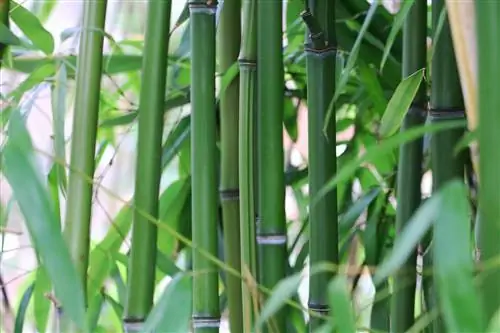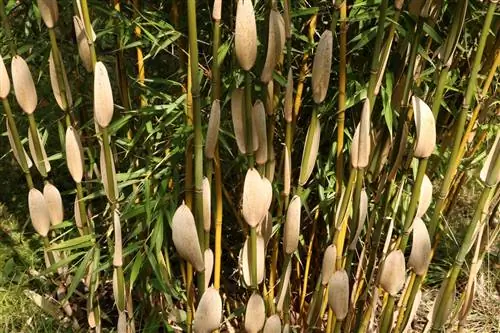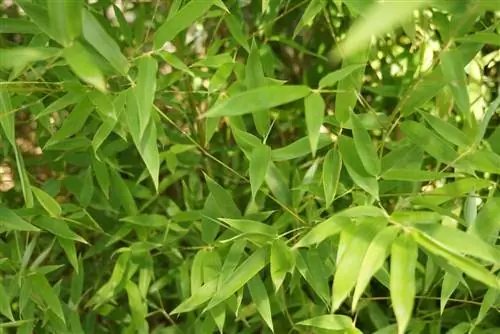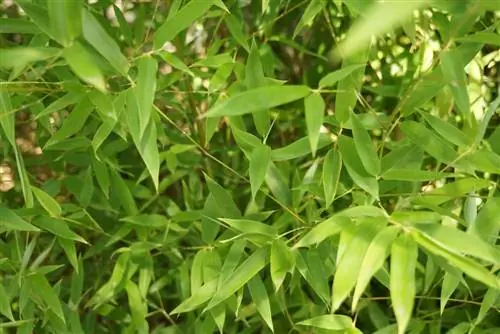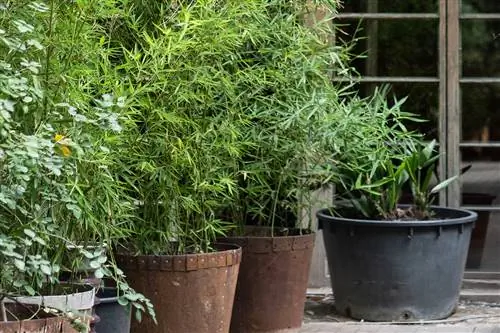- Author admin [email protected].
- Public 2023-12-17 03:39.
- Last modified 2025-01-24 12:45.
The Lucky Bamboo has been known in Asian culture for an incredible 4,000 years as a plant with magical abilities. Perhaps the oldest herbal lucky charm for humans, it is said to ensure good he alth and old age, and it also brings great we alth with it. The reason for the attribution of all these talents is quickly explained when you read the following care instructions: A lucky bamboo grows even in very little light and hardly needs any water. Anyone who can thrive in such poor living conditions is certainly rightly revered as a special lucky child and powerhouse.
Short profile of Lucky Bamboo
- The lucky bamboo is not a bamboo, but a dragon tree (Dracaena)
- Dracaena fragrans stedneri and D. sanderiana are sold as lucky bamboo
- The homeland of these plants is in the tropics of Asia and Africa
- When kept correctly, an undemanding and easy-care plant
- Can set accents in a trendy rod shape
- But can also be grown into a bushy houseplant of mighty size
- Popular lucky charm that, among other things, is given as a gift for Christmas and New Year
Location
The tropical plant is used to a warm and rainy climate, with shade from the canopy of higher plants, so these conditions must be recreated in the room as best as possible:
- Location in partial shade or with some sun
- Without permanent direct sunlight
- Temperatures above 18°C
- The Lucky Bamboo needs high humidity around it
Due to the need for high humidity, the lucky bamboo can be placed very well in the bathroom or kitchen, in these rooms the humidity is higher than in the living rooms. If you want to place the lucky bamboo in a dry room, you would need to mist it regularly with a flower sprayer.
Tip:
The plant, also known as Happy Bamboo, will delight you in the garden or on the balcony. However, you always have to keep an eye on the temperatures; the lucky bamboo is only allowed outside when the thermometer does not drop below 18° C at night. If the air outside is dry, the “water bamboo” needs to be sprayed more often.
Pot and substrate
The lucky bamboo can be kept in several ways:
- In a small container filled with water, this is how it is often sold
- In wet sticking material
- In hydroponic substrate
- In other plant granules such as perlite
- In standard soil for green plants
Even if the lucky bamboo does not rely on substrate - if you want to live with a lucky bamboo for a longer period of time and without a lot of care, we recommend keeping it in soil. When kept without a substrate in a few centimeters of water, you always have to supply exactly the right amount of nutrients, which is almost impossible and therefore shortens the lifespan of the corn plant in most cases. A lucky bamboo in pre-fertilized green plant soil, on the other hand, is really easy to care for and requires hardly any attention.
Rooting
The prerequisite for keeping in soil is that the lucky bamboo has developed roots. This is not a given, especially around the holidays, when retailers usually only sell freshly cut Lucky Bamboo pieces that have not yet had time to take root. You would now have to root these plant parts first before you plant them; the best way to do this is to keep the pieces in water first. After some time, roots will form and when they have reached a few centimeters in length (hand width), you can plant the Lucky Bamboo. If the lucky bamboo piece is quite thin and has perhaps become even taller in the water, you should insert a support rod into the pot.
Tip:
If you keep the Lucky Bamboo without a substrate, theoretically a narrow container is sufficient, but in practice this often leads to the Lucky Bamboo quickly falling over. A heavy planter or a narrow and tall glass vase that has a wide base ensures more stability. Or you can create small landscapes with your Feng Shui Bamboos, several stems next to each other in a box filled with gravel.
Pour or refill water
A lucky bamboo in soil or substrate is watered normally, but please use soft water, it doesn't tolerate lime very well. Whether hydroponics or soil - the water supply should be so regular that the substrate is always slightly moist.
If you keep the Lucky Bamboo in pure water without a substrate, you usually just need to add water so that the roots are covered. A complete water change is possible, e.g. B. if dirt has gotten into the water, then remember to add the necessary nutrients to this water.
Whenever you keep it, you should pay close attention to ensuring that the roots of the lucky bamboo are never dry or dry out. In addition, in many locations a Lucky Bamboo has to be watered “from outside”, namely with a flower sprayer, in order to create the desired high humidity. When giving water, no matter in what form, please do not shock your lucky bamboo with cold water from the tap, but have stale water at room temperature ready.
Fertilize
When and how the lucky bamboo needs to be fertilized depends on the husbandry:
- A Lucky Bamboo in soil does not need any additional fertilizer for the first quarter of a year after being potted
- Then it is fertilized with normal liquid fertilizer for green plants in a weak concentration
- A Lucky Bamboo in inorganic hydroponics and substrates needs regular nutrients
- It's exactly the same with the lucky bamboo kept permanently in water without a substrate
- The fertilizer must be applied regularly and frequently, about every two weeks
- Only a small amount of fertilizer is added to the water each time
Tip:
Special Lucky Bamboo or lucky bamboo fertilizer is sold in specialist stores, which can be used for dewatering, hydroponics or soil farming. If you know a little about fertilizers and the labeling of ingredients, you can also use any other green plant fertilizer with an NPK of around 2/1/2. It is more important to dilute the liquid fertilizer with water and not to add too much.
Repotting
Lucky bamboo in water can be placed in a larger container if it gets too high. Lucky bamboo in substrate should be repotted into new substrate annually, with thorough cleaning of the roots (disease prevention).
Cutting
Like any dragon tree, the Lucky Bamboo can be pruned very well, and there are several reasons to do so:
- You can make a bushy plant out of a stick
- For this purpose, thin side shoots are cut off continuously and everywhere
- There are branches that gradually become more lush
- The removed side shoots can be used for propagation
- Dead, rotten and diseased plant parts are cut away
- This has to be done well into the he althy range
Propagate
You can multiply your lucky bamboo in three ways:
- Propagation by seeds is possible in principle, but difficult in practice
- Seeds can only be obtained from flowers
- Flowers are only formed on older plants from the 10th year of life onwards
- These then have to be fertilized
- Removing the tiny seeds is also a puzzle job
- Propagation from seeds is therefore not recommended
- Propagation from cuttings is easy, but doesn't always work
- Side shoots are separated directly from the trunk
- You can e.g. B. use the side shoots that you gain from training pruning
- Use a sharp and clean (disinfected) knife
- The side shoots should each be eight to ten centimeters long
- They are placed in a container with a little water
- Covering with foil or plastic bag increases the humidity
- When the first roots appear, the young plants are transferred to the growing medium
- Propagation works in a similar way by dividing stems
- The trunk is cut into ten centimeter long pieces
- After rooting in water, the plants can be transferred to substrate
When propagating by cuttings or by dividing stems, you should not become impatient: the first roots can take a few weeks or months to appear.
Tip:
Sometimes you can read that a lucky bamboo must not be cut under any circumstances because it would then die and you would cut up your luck. Almost a philosophical question, but common sense says the opposite: every dragon tree comes to life through pruning, and with the lucky bamboo that is precisely the reason why it is revered as a good luck charm - so disinfect your knives and get your hands on the lucky bamboo!
Wintering
Overwintering the lucky bamboo is not a problem; you can simply cultivate it at a temperature that is as consistent as possible. Avoid drafts (location by the window!), moisten the dry heating air by regularly spraying the lucky bamboo.
Species
Two types of dragon trees are sold under the label Glücksbamboo or Lucky Bamboo:
- Dracaena sanderiana, often many small plants in the arrangement
- Dracaena fragrans of the variety “Stedneri”, usually single and long-stemmed
- Dracaena fragrans Stedneri is also available as a larger plant (around 30 cm)
Which type of plant you get, also known as Happy Bamboo, Feng Shui Bamboo, Water Bamboo, Dragon Tree, Dracaena Lucky or Corn Plant, you can e.g. You can recognize it by its shape, for example, Dracaena fragrans stedneri is usually shaped like a spiral. But it doesn't really matter, all lucky bamboos are equally undemanding when it comes to care.
Frequently asked questions
What can I do against yellow rot on lucky bamboo?
Sudden yellowing of the trunk without any noticeable lack of care is not uncommon with the Lucky Bamboo; the cause of this yellow rot is suspected to be an infection with unknown pathogens (bacteria, mold). Only quick action at the first yellow spot can now save the lucky bamboo from rotting: Cut off the yellow trunk piece, using gloves and a disinfected knife and far into the he althy part, clean the pot and replace the substrate, The lucky bamboo usually sprouts again.
Is it true that the Lucky Bamboo is poisonous?
Yes, which shouldn't usually give you a headache, a person would have to absorb quite a lot of the saponins contained in lucky bamboo, and why should they do that?However, if there are children in your household of an age that would make it conceivable to eat a lucky bamboo or take a drink from the container, you should, as a precaution, avoid using the lucky charm (also with curious pets).


